Iceland Airwaves 2017 review - political change at Reykjavík's major music festival | reviews, news & interviews
Iceland Airwaves 2017 review - political change at Reykjavík's major music festival
Iceland Airwaves 2017 review - political change at Reykjavík's major music festival
Brow-furrowing breakbeats and Russian post-punk jostle for attention in the land of lava
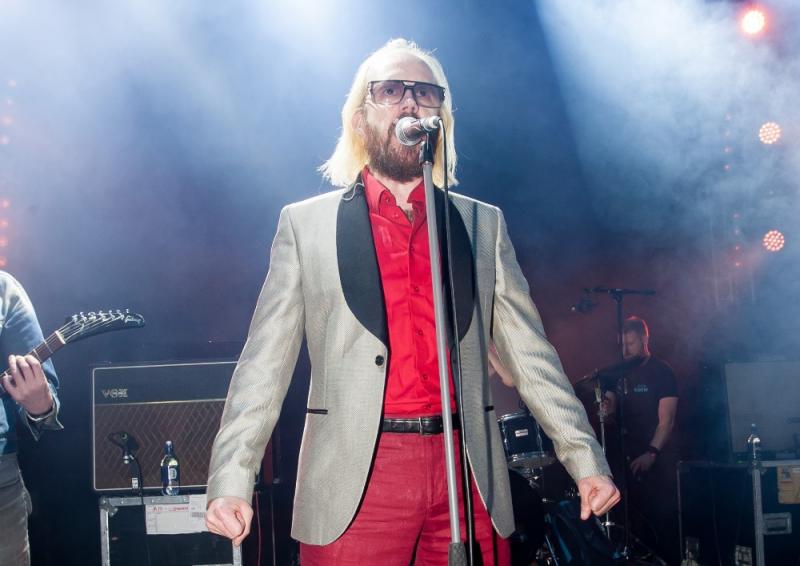
Óttarr Proppé, the stylish chap pictured above, was appointed Iceland’s Minister of Health in January this year. Last Saturday, when the shot was taken, he was on stage in his other role as the singer of HAM, whose invigorating musical blast draws a line between the early Swans and Mudhoney.
While rare but not unknown for political office and active involvement in rock music to co-exist, Proppé was in what must have been a unique position. As an MP, the Chairman of the Bright Future Party and a minister, it was he who triggered the election. The incumbent right-wing Prime Minister Bjarni Benediktsson dissolved Parliament after Proppé said Bright Future could not support the existing coalition due to a loss of trust. Benediktsson had been implicated in a cover-up.
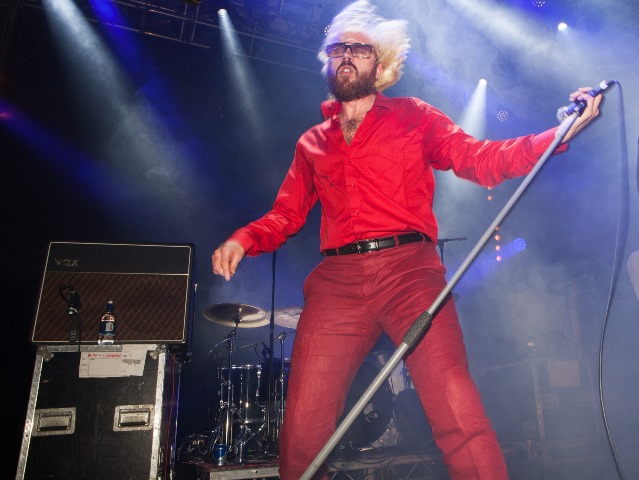 At the time of performing with HAM at the annual Iceland Airwaves festival, a new ruling consensus had not yet been formed but one outcome was certain: Bright Future was wiped out. Proppé’s party lost their seats and it looked as though a new, left-leaning coalition would assume power. In all, it’s a lesson that what you see in Iceland is not necessarily the whole picture. Even at a gig. (pictured right, Óttarr Proppé in full flow at Reykjavík’s Art Museum © Rúnar Sigurður Sigurjónsson)
At the time of performing with HAM at the annual Iceland Airwaves festival, a new ruling consensus had not yet been formed but one outcome was certain: Bright Future was wiped out. Proppé’s party lost their seats and it looked as though a new, left-leaning coalition would assume power. In all, it’s a lesson that what you see in Iceland is not necessarily the whole picture. Even at a gig. (pictured right, Óttarr Proppé in full flow at Reykjavík’s Art Museum © Rúnar Sigurður Sigurjónsson)
And so it is with Airwaves. Neon-light names like Arab Strap, Billy Bragg, Benjamin Clementine, Fleet Foxes, Michael Kiwanuka, Mumford & Sons, Songhoy Blues and Iceland’s own Ásgeir ensure a substantial foreign audience is in town – attracted by the combination of the top-flight bill and all-in packages sold by sponsor Icelandair. There are, though, alternatives.
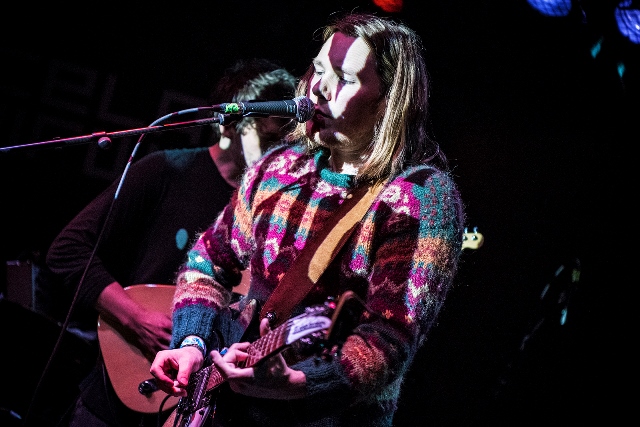 Through a thoughtful booking process which brings five days of music to 13 venues (all day, every day there are also countless off-venue shows), Airwaves complements the well-known names by offering chances to take in a raft of international up-and-comers, local favourites which aren’t well-known to the outside world, native trends including a seemingly endless supply of home-grown hip-hop, a potted history of Icelandic rock and numerous just-off-the-ground Icelanders who might be the next Amiina, müm or even Of Monsters and Men. Going with the flow is easy but attending Airwaves without sniffing out the unfamiliar and swotting-up on Iceland’s own music would be a wasted opportunity.
Through a thoughtful booking process which brings five days of music to 13 venues (all day, every day there are also countless off-venue shows), Airwaves complements the well-known names by offering chances to take in a raft of international up-and-comers, local favourites which aren’t well-known to the outside world, native trends including a seemingly endless supply of home-grown hip-hop, a potted history of Icelandic rock and numerous just-off-the-ground Icelanders who might be the next Amiina, müm or even Of Monsters and Men. Going with the flow is easy but attending Airwaves without sniffing out the unfamiliar and swotting-up on Iceland’s own music would be a wasted opportunity.
Nothing exemplifies the latter more than Rythmatik (pictured above left, © Florian Trykowski). In the basement of the Hard Rock café – the increasingly tourist-servicing Reykjavík has one: no McDonald’s though – their enthusiasm makes them enjoyable whatever the nature of their music. A young-seeming guitar band, Rythmatik take the driving Eighties’ sound of Big Country and U2 to create a pop-rock stuffed with memorable choruses and melodies. In contrast, at the grimy bar Hurra, Dillalude cook up a brow-furrowing stew so offbeat it could only be Icelandic. A DJ with two turntables is accompanied by two analogue synth players, a trumpet player and a virtuoso drummer whacking out what amounts to live breakbeats. Dillalude’s head-spinning cut-and-paste take on Herbie Hancock’s Headhunters is as memorable as it is demanding.
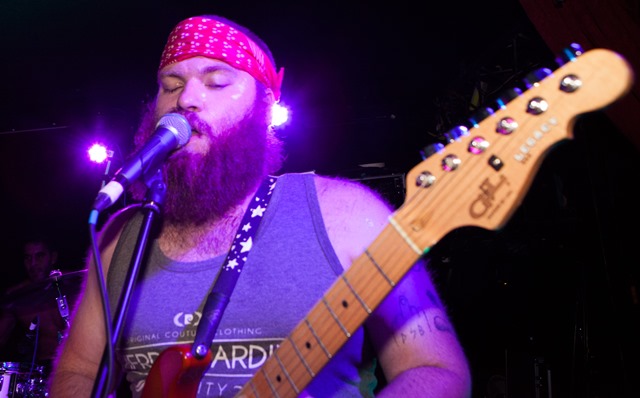 Also at Hurra, SiGRÚN similarly could only be Icelandic. Sigrún Jónsdóttir has previously played live with Björk, Florence & the Machine and Sigur Rós but her mono-monikered trio is its own thing. Based around circular vocal chants suggesting the liturgical, each piece was underpinned by fragmented waves of electronic wash. A player bowing a double bass enhanced the feeling this music encapsulates the oceanic. Her second accompanist loomed above a table top littered with what appeared to be gold rocks. Waving her hands over them like a Theremin player, she conjured rhythmic pulses. In another place and time, SiGRÚN would have been at one with jazz-influenced New York minimalism. Offset this against the full-on, shout-infused noise of bass guitar and drums duo ROHT, upstairs from Hurra at Gaukurinn, and it’s evident Airwaves has no problem inviting the challenging on board.
Also at Hurra, SiGRÚN similarly could only be Icelandic. Sigrún Jónsdóttir has previously played live with Björk, Florence & the Machine and Sigur Rós but her mono-monikered trio is its own thing. Based around circular vocal chants suggesting the liturgical, each piece was underpinned by fragmented waves of electronic wash. A player bowing a double bass enhanced the feeling this music encapsulates the oceanic. Her second accompanist loomed above a table top littered with what appeared to be gold rocks. Waving her hands over them like a Theremin player, she conjured rhythmic pulses. In another place and time, SiGRÚN would have been at one with jazz-influenced New York minimalism. Offset this against the full-on, shout-infused noise of bass guitar and drums duo ROHT, upstairs from Hurra at Gaukurinn, and it’s evident Airwaves has no problem inviting the challenging on board.
Indeed, since the arrival of punk rock here in 1978 Iceland has accommodated musical extremes with ease. For Airwaves, the most convincing contemporary punks are the gale-force, figuratively halitosis-flavoured Pink Street Boys (pictured above right, © Rúnar Sigurður Sigurjónsson). Fræbbblarnir, the country’s first punk rock band, were also playing. At The Hard Rock Café, the venerable outfit sounded much as they must have 39 years ago: scrappy and fun. As they covered The Jam’s “Carnaby Street”, it was hard not to reflect on the incongruity of two of The Jam’s stages suits being displayed in glass cases on the room’s opposite wall – a mind-boggling juxtaposition between setting rock’s history in aspic and going for it, for real and in person.
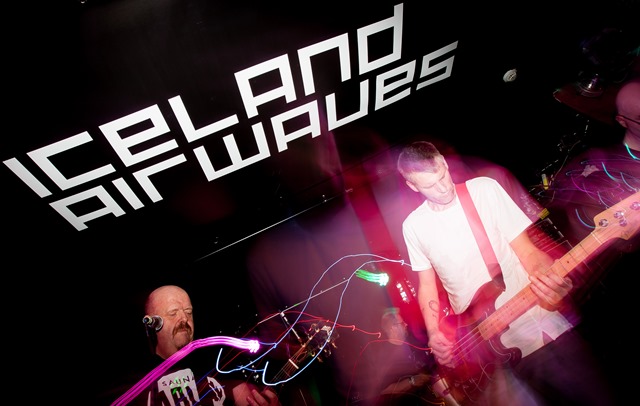 Further acknowledgement that Iceland’s musical past is alive, well and still fit for purpose came with HAM – who formed in 1988 – and a terrific outing from Dr. Gunni (pictured left, with Dr. Gunni left © Sigurður Ástgeirsson), whose old band S.H. Draumur supported The Sugarcubes in London. His kinetic, second-album Clash, powerpop-punk was a breath of fresh air. Another stich integral to Iceland’s rich rock tapestry at Airwaves is Tappi Tíkarrass. In 1981, their singer was Björk. The 2017 line-up does not feature her but is otherwise all original.
Further acknowledgement that Iceland’s musical past is alive, well and still fit for purpose came with HAM – who formed in 1988 – and a terrific outing from Dr. Gunni (pictured left, with Dr. Gunni left © Sigurður Ástgeirsson), whose old band S.H. Draumur supported The Sugarcubes in London. His kinetic, second-album Clash, powerpop-punk was a breath of fresh air. Another stich integral to Iceland’s rich rock tapestry at Airwaves is Tappi Tíkarrass. In 1981, their singer was Björk. The 2017 line-up does not feature her but is otherwise all original.
Of the bands embraced by contemporary mainstream Iceland, two stand out: Mammút and Valdimar. Mammút were the home-grown highlight of last year’s Airwaves and, this time round, their circular songs are even more hard edged. They should be playing Brixton’s Academy. The trombone-wielding bandleader Valdimar (pictured below right, © Florian Trykowski) used to deal in a folk-rock; a sinuously wonky take on Americana. His and his band’s style still have that approach but the means of delivery has changed, implying he may have taken a hard look at Dexy’s Midnight Runners’ first album and the drive of early Oasis to marry them with what was there already. One conclusion presents itself: Valdimar has patented Iceland’s counterpart to Van Morrison’s Celtic Soul.
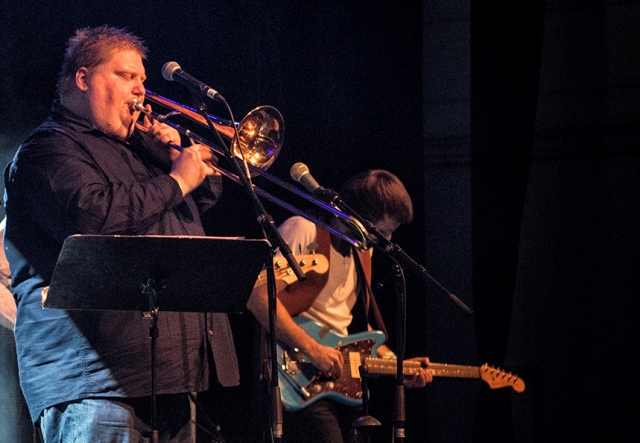 In an intimate contrast to the grand gestures of Mammút and Valdimar, an airy annex of the downtown mansion Hannesarholt hosted Kristjana Stefáns and Svavar Knútur in the musical equivalent of taking time out for reflection. Neither lacked intensity but while sat at a piano Stefáns’ songs questioning the nature of personal perceptions brought to mind what a jazz-inclined take on Broadcast could have been. Singer-songwriter Knútur was more direct and romped through deliberations on the impact of death, family dynamics and sex. While his subject matter was weighty, his song introductions were hilarious free-form disquisitions on anything from playing a vegan wedding to wanting to get one of his songs into an imagined US TV series of Fifty Shades of Grey.
In an intimate contrast to the grand gestures of Mammút and Valdimar, an airy annex of the downtown mansion Hannesarholt hosted Kristjana Stefáns and Svavar Knútur in the musical equivalent of taking time out for reflection. Neither lacked intensity but while sat at a piano Stefáns’ songs questioning the nature of personal perceptions brought to mind what a jazz-inclined take on Broadcast could have been. Singer-songwriter Knútur was more direct and romped through deliberations on the impact of death, family dynamics and sex. While his subject matter was weighty, his song introductions were hilarious free-form disquisitions on anything from playing a vegan wedding to wanting to get one of his songs into an imagined US TV series of Fifty Shades of Grey.
Their culture may have been in the air, but it wasn’t the visiting Americans who made musical waves at Airwaves. Iðnó is a charming 1890s ballroom which has seen a lot of diverse music in its life, so Xyloris White made perfect sense there. The duo of Cretan lute player Giorgos Xyloris (pictured below left, © Ásta Sif Árnadóttir) and the Dirty Three’s Jim White thrashed through an extraordinary set of instrumentals which can be taken as drone-psychedelia (albeit at warp speed) and jazz-fusion. Utterly vital and in line with concept of Fourth World Music, where styles collide to produce something new.
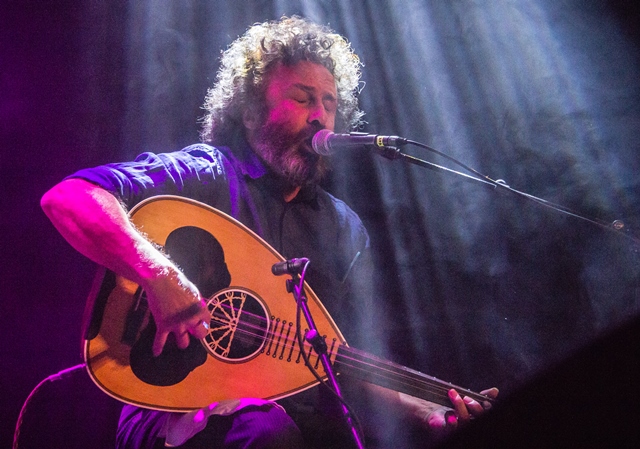 On the same stage, former Cocteau Twin Simon Raymonde and Dif Juz drummer Richie Thomas' new band Lost Horizons showcased a music which was equally hard to place. The drama of John Cale is perceptible, as are touches of a Bowie-influenced rock theatre. Lost Horizons connect the dots between the pre-punk gothic songwriting of, say, David Ackles and the subterranean world of 4AD Records.
On the same stage, former Cocteau Twin Simon Raymonde and Dif Juz drummer Richie Thomas' new band Lost Horizons showcased a music which was equally hard to place. The drama of John Cale is perceptible, as are touches of a Bowie-influenced rock theatre. Lost Horizons connect the dots between the pre-punk gothic songwriting of, say, David Ackles and the subterranean world of 4AD Records.
In this spirit, Sweden’s Hey Elbow pulled off the unlikely feat of suggesting Dead Can Dance, Laibach and sweet Scandinavian pop all at once. Although solo, Russia’s Miss Naivety occupies the same space, where mood is a major driver of the song. Which is what, with a full band and local string section, Finland’s Mikko Joensuu runs with to so great a degree that he pushes his songs towards heaven. Waves and waves of beautiful sound build and build until the transcendence achieved spills off the stage into the audience.
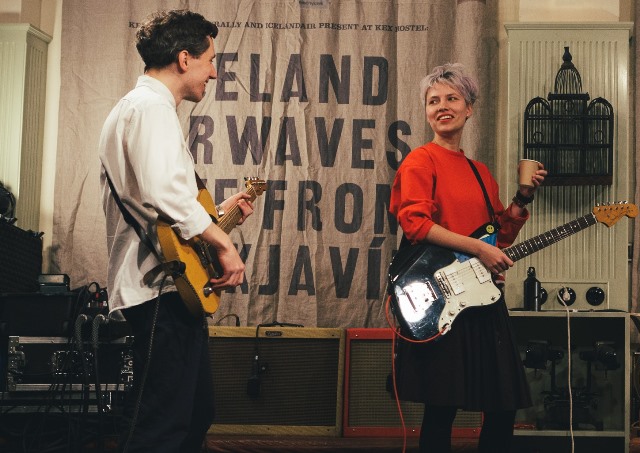 Of course, reaching for the ecstatic is not necessary to leave an impression. Russia’s Glintshake (pictured right, © Alexander Matukhno) appear to deal in a specific: the sound of 1981, in particular that of Birmingham’s Au Pairs as they were that year. The Gang of Four are in there too but The Au Pairs resonate most, even down to the on-stage moves between their female singer-guitarist and male guitarist. Yet Glintshake step beyond what they seemingly draw on to create a compellingly contemporary narrative. Anyone without a head packed full of touchstones would be on board immediately, as evidenced by the animated audience reaction between each angular song. Not everyone was thinking “ah, early Eighties UK post-punk.”
Of course, reaching for the ecstatic is not necessary to leave an impression. Russia’s Glintshake (pictured right, © Alexander Matukhno) appear to deal in a specific: the sound of 1981, in particular that of Birmingham’s Au Pairs as they were that year. The Gang of Four are in there too but The Au Pairs resonate most, even down to the on-stage moves between their female singer-guitarist and male guitarist. Yet Glintshake step beyond what they seemingly draw on to create a compellingly contemporary narrative. Anyone without a head packed full of touchstones would be on board immediately, as evidenced by the animated audience reaction between each angular song. Not everyone was thinking “ah, early Eighties UK post-punk.”
Once they finished, spontaneous discussions broke out about what had just been witnessed. A Russian member of the audience noted that Glintshake’s major influence could be the mid-Eighties counter-cultural singer Zhanna Aguzarova. Indeed, a check of her recorded works suggests this might be the case.
As it was with Óttarr Proppé and HAM, what you see in Iceland – even if it is Russian – does not necessarily reveal the whole picture. At Airwaves, spoon-feeding is kept to a minimum. Audiences are left to figure out the full story.
The future of Arts Journalism
You can stop theartsdesk.com closing!
We urgently need financing to survive. Our fundraising drive has thus far raised £49,000 but we need to reach £100,000 or we will be forced to close. Please contribute here: https://gofund.me/c3f6033d
And if you can forward this information to anyone who might assist, we’d be grateful.

Subscribe to theartsdesk.com
Thank you for continuing to read our work on theartsdesk.com. For unlimited access to every article in its entirety, including our archive of more than 15,000 pieces, we're asking for £5 per month or £40 per year. We feel it's a very good deal, and hope you do too.
To take a subscription now simply click here.
And if you're looking for that extra gift for a friend or family member, why not treat them to a theartsdesk.com gift subscription?
more New music
 Solar Eyes, Hare & Hounds, Birmingham review - local lads lay down some new tunes for a home crowd
Psychedelic indie dance music marinated in swirling dry ice
Solar Eyes, Hare & Hounds, Birmingham review - local lads lay down some new tunes for a home crowd
Psychedelic indie dance music marinated in swirling dry ice
 Music Reissues Weekly: Evie Sands - I Can’t Let Go
Diligent, treasure-packed tribute to one of Sixties’ America’s great vocal stylists
Music Reissues Weekly: Evie Sands - I Can’t Let Go
Diligent, treasure-packed tribute to one of Sixties’ America’s great vocal stylists
 'Deadbeat': Tame Impala's downbeat rave-inspired latest
Fifth album from Australian project grooves but falls flat
'Deadbeat': Tame Impala's downbeat rave-inspired latest
Fifth album from Australian project grooves but falls flat
 Heartbreak and soaring beauty on Chrissie Hynde & Pals' Duets Special
The great Pretender at her most romantic and on the form of her life
Heartbreak and soaring beauty on Chrissie Hynde & Pals' Duets Special
The great Pretender at her most romantic and on the form of her life
 The Last Dinner Party's 'From the Pyre' is as enjoyable as it is over-the-top
Musically sophisticated five-piece ramp up the excesses but remain contagiously pop
The Last Dinner Party's 'From the Pyre' is as enjoyable as it is over-the-top
Musically sophisticated five-piece ramp up the excesses but remain contagiously pop
 Moroccan Gnawa comes to Manhattan with 'Saha Gnawa'
Trance and tradition meet Afrofuturism in Manhattan
Moroccan Gnawa comes to Manhattan with 'Saha Gnawa'
Trance and tradition meet Afrofuturism in Manhattan
 Soulwax’s 'All Systems Are Lying' lays down some tasty yet gritty electro-pop
Belgian dancefloor veterans return to the fray with a dark, pop-orientated sound
Soulwax’s 'All Systems Are Lying' lays down some tasty yet gritty electro-pop
Belgian dancefloor veterans return to the fray with a dark, pop-orientated sound
 Music Reissues Weekly: Marc and the Mambas - Three Black Nights Of Little Black Bites
When Marc Almond took time out from Soft Cell
Music Reissues Weekly: Marc and the Mambas - Three Black Nights Of Little Black Bites
When Marc Almond took time out from Soft Cell
 Album: Mobb Deep - Infinite
A solid tribute to a legendary history
Album: Mobb Deep - Infinite
A solid tribute to a legendary history
 Album: Boz Scaggs - Detour
Smooth and soulful standards from an old pro
Album: Boz Scaggs - Detour
Smooth and soulful standards from an old pro
 Emily A. Sprague realises a Japanese dream on 'Cloud Time'
A set of live improvisations that drift in and out of real beauty
Emily A. Sprague realises a Japanese dream on 'Cloud Time'
A set of live improvisations that drift in and out of real beauty
 Trio Da Kali, Milton Court review - Mali masters make the ancient new
Three supreme musicians from Bamako in transcendent mood
Trio Da Kali, Milton Court review - Mali masters make the ancient new
Three supreme musicians from Bamako in transcendent mood

Add comment